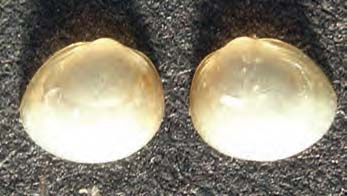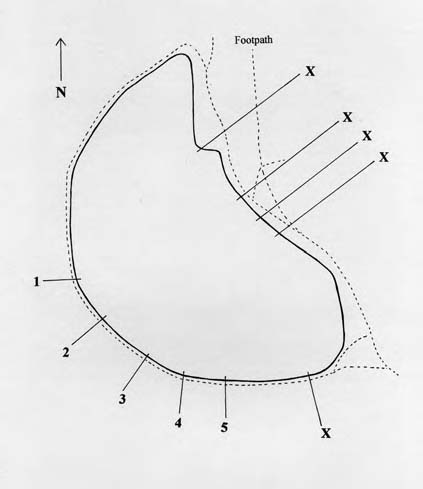|
Lake Gormire lies at the edge of the Hambleton escarpment in North-east Yorkshire (VC 62. Grid ref. SE5183). Situated on oolitic limestone at an altitude of 160m it is a small lake of approximately 400m in maximum length and is unusual in that no streams enter or leave it (fig 1). Gormire is one of only two natural lakes in Yorkshire, the other being the somewhat better known Malham Tarn, far to the west in the Pennines. The pea mussel Pisidium lilljeborgii is a boreal relict with a north-westerly distribution in Britain (Kerney 1999; Killeen et al. 2004) and in Yorkshire it has been recorded only from Malham Tarn and Lake Gormire, the latter being its most easterly known locality in Britain. Historically, following its discovery in Malham Tarn early in the twentieth century (Stratton 1956), Charles Oldham suggested that it might also occur in Gormire and, in the company of Bernard Lucas, set out to look for it in August 1928. The expedition proved Oldham’s prediction correct; in his words “we collected a good many specimens [of P. lilljeborgii] in calcareous mud in which Littorella [Shoreweed] and Myriophyllum [Water Milfoil] were growing, where it was associated with P. nitidum and P. hibernicum” (Oldham 1929). He went on to add “Mr Lucas on a previous visit collected P. casertanum, milium and nitidum in black vegetable mud at the roots of Menyanthes [Bogbean]. Other molluscs living in Gormire are Planorbis albus, Valvata piscinalis and Sphaerium corneum.” Since that time there do not appear to be any further records of the occurrence of P. liljeborgii in Lake Gormire (Adrian Norris, pers. comm. Table 1). In view of this, the lake was visited on 13th July 2005 with the aim of trying to re-find it. Samples were collected from a series of sites around the margin using a wire mesh sieve of guage approximately 2mm and diameter 180mm (i.e. a kitchen sieve) attached to a pole extendable to 2.4m. Samples were collected from shallow areas usually less than 0.3m in depth and within 4m of the margin. Five specimens of P.lilljeborgii were among the Mollusca collected (Fig 2) these being from sites along the south-west margin of the lake. P.lilljeborgii was not found at sites elsewhere (Fig. 3). GPS grid references could not be taken on the day due to reception problems caused by the tree canopy. The lake was revisited on 19th November 2006 with the aim of trying to learn more about the distribution of P.lilljeborgii. On this occasion it was possible to obtain GPS grid references and P.lilljeborgii was located at four out of five sampling points along the south-west margin, all in areas with little or no vegetation and a substratum of mixed particle size; a silty mud with some grit (Fig. 3 and Table 2). This contrasts with the habitat described by Oldham and noted above; calcareous mud with Littorella and Myriophyllum. Oldham found P.nitidum and P.hibernicum associated with P.lilljeborgii but in the present survey only the former was noted as an associate, P.hibernicum not being found in the lake at all. P.nitidum was the most common Pisidium in the samples taken. In 2005 and 2006 extensive areas of bogbean (Menyanthes trifoliata) were noted around the lake margin, with a substratum of black, decaying vegetable matter. Samples taken from such sites included P.milium and P.nitidum along with Potamopyrgus antipodarium and Sphaerium corneum but not P.lilljeborgii. Acknowledgements We are grateful to Adrian Norris for confirming identification of specimens of P.lilljeborgii collected on 13th July 2005 and for providing records for Lake Gormire collected by J.A. Pators and Dr L. Lloyd-Evans. References Kerney, M.P. 1999. Atlas of the Land and Freshwater Molluscs of Britain and Ireland. Harley Books: Colchester. Killeen, I., Aldridge D. & Oliver G. 2004. Freshwater Bivalves of Britain and Ireland. Field Studies Council & National Museum of Wales: Cardiff. Oldham, C. 1929. Pisidium lilljeborgii in N E Yorkshire. J. Conchology 18: 294. Stratton, L.W. 1956. The Mollusca of the Malham area. J. Conchology 24: 111-138. |
Fig 1 Lake Gormire
Fig 2 Pisidium lilljeborgii from Lae Gormire 13/7/2005
Fig 3 Sketch map of Lake Gormire showing sampling sites. No grid lines are shown as the whole lake falls within SE5083 1 – 4: sites where P.lilljeborgii was located on 19.11.2006 5: P.lilljeborgii not located 19.11.2006 X: P.lilljeborgii not located on 13.7 2005
|
Table 1 Mollusca recorder from Lake Gormire, a summary
| Species | Oldam | Pators | Lloyd-Evans | Current survey | Current survey |
| 1929 | 09/1967 | 7/9/1974 | 13/7/2005 | 19/11/2006 | |
| V. piscinalis | * | ||||
| P. antipodarium | * | * | |||
| P. fontinalis | * | ||||
| L. stagnalis | * | ||||
| B. contortus | * | ||||
| G. albus | * | * | * | ||
| H. complanatus | * | * | |||
| S. corneum | * | * | * | * | |
| P. casertanum | * | * | |||
| P. milium | * | * | * | * | * |
| P. subtruncatum | * | ||||
| P. lilljeborgii | * | * | * | ||
| P. hibernicum | * | ||||
| P. nitidum | * | * | * |
Table 2 Mollusca recorded at Lake Gormire 19/11/2006
| Site no. | GPS Grid Ref. | Species | Substratum |
| 1 | SE50176.83152 | P. antipodarium S. corneum P. lilljeborgii |
Silty mud and grit |
| 2 | SE50216.83140 | P .antipodarium L. stagnalis P. lilljeborgii P. nitidum |
Silty mud and grit |
| 3 | SE50277.83096 | G. albus P. lilljeborgii P. nitidum |
Silty mud and grit |
| 4 | SE50323.83093 | P. lilljeborgii P. nitidum |
Silty mud and grit |
| 5 | SE50369.83093 | S. corneum P. nitidum |
Silty mud and grit with a sparse cover of Littorella |



